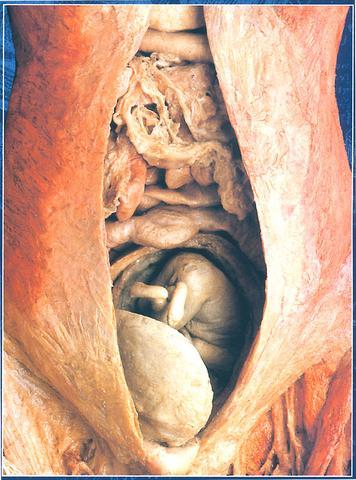"My penchant for hats, for instance, is not reflective of an artistic demeanor; it has more to do with my self-image as an inventor," writes Gunther von Hagens, the German inventor of "plastination."
At the unveiling earlier this week in Taipei of Body Worlds, The Anatomical Exhibition of Real Human Bodies, the professor stayed on pitch, lauding his achievements and sharing the details of his enterprise.

PHOTO COURTESY OF BODY WORLDS
As he swept out of the conference room and took the media on a tour of the exhibition -- his trademark hat topped off the sartorial statement of his dark tailored suit -- he seemed to be an apt underworld figure: the guardian of the dead.
He had a laser pen which he pointed at some of his favorite items, the cross-sectioned slice through a liver, for example, pointing out the spleen nearby, and the thoracic vertebra. Or, a selection of artistically posed dead bodies, one playing chess.
He also hammed it up with the museum directors and a senior academic for the TV cameras -- but in a suitably restrained manner, befitting an undertaker.
With him was Angelina Whalley, a long-term collaborator of von Hagens who does the planning for his exhibitions. She dealt with reporters who asked questions such as: "Why aren't there more women [plastinated in the exhibition]. Is it because they're more shy?"
"Perhaps, but that's not the reason," she replied.
Whalley and von Hagens control the patents for plastination and the company that makes the plastic polymers used in the process, in which resins replace the bodily fluids that make up 70 percent of the body. The rest of the body is embalmed in a variety of ways.
The exhibitions have been hugely popular since the first in Mannheim, Germany, in 1997 and have helped pay for plastination institutes in Heidelberg, Germany; Kyrgyzstan; and Dalian, China.
Von Hagens energetically promotes his work and has appeared on a float in the Berlin Love Parade wearing a "skeleton" costume. He did a dissection in front of a London audience last year.
Clearly, he is a man with a mission. His heroes are his forebears in anatomy, from Plato to Leonardo da Vinci, to Honore Fragonard. He says he thinks about plastination all the time and the result is a show of the human body that is, of course, revealing, and also inspiring.
As an entertainer, inventor and keeper of the dead, von Hagens has scored a deserved hat trick.

June 2 to June 8 Taiwan’s woodcutters believe that if they see even one speck of red in their cooked rice, no matter how small, an accident is going to happen. Peng Chin-tian (彭錦田) swears that this has proven to be true at every stop during his decades-long career in the logging industry. Along with mining, timber harvesting was once considered the most dangerous profession in Taiwan. Not only were mishaps common during all stages of processing, it was difficult to transport the injured to get medical treatment. Many died during the arduous journey. Peng recounts some of his accidents in

“Why does Taiwan identity decline?”a group of researchers lead by University of Nevada political scientist Austin Wang (王宏恩) asked in a recent paper. After all, it is not difficult to explain the rise in Taiwanese identity after the early 1990s. But no model predicted its decline during the 2016-2018 period, they say. After testing various alternative explanations, Wang et al argue that the fall-off in Taiwanese identity during that period is related to voter hedging based on the performance of the Democratic Progressive Party (DPP). Since the DPP is perceived as the guardian of Taiwan identity, when it performs well,

A short walk beneath the dense Amazon canopy, the forest abruptly opens up. Fallen logs are rotting, the trees grow sparser and the temperature rises in places sunlight hits the ground. This is what 24 years of severe drought looks like in the world’s largest rainforest. But this patch of degraded forest, about the size of a soccer field, is a scientific experiment. Launched in 2000 by Brazilian and British scientists, Esecaflor — short for “Forest Drought Study Project” in Portuguese — set out to simulate a future in which the changing climate could deplete the Amazon of rainfall. It is

The Taiwan People’s Party (TPP) on May 18 held a rally in Taichung to mark the anniversary of President William Lai’s (賴清德) inauguration on May 20. The title of the rally could be loosely translated to “May 18 recall fraudulent goods” (518退貨ㄌㄨㄚˋ!). Unlike in English, where the terms are the same, “recall” (退貨) in this context refers to product recalls due to damaged, defective or fraudulent merchandise, not the political recalls (罷免) currently dominating the headlines. I attended the rally to determine if the impression was correct that the TPP under party Chairman Huang Kuo-Chang (黃國昌) had little of a